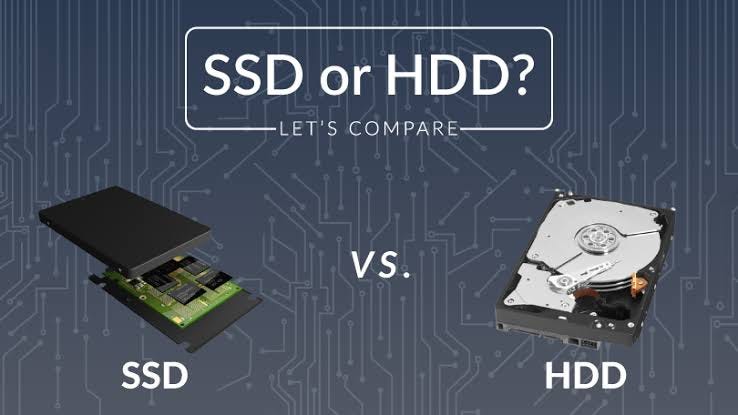Computer Assembly Series Part 2 RAM & Storage (HDD, SSD)
Memory (RAM) Selection
Memory (RAM) is one of the key components that directly affects the performance of a computer. RAM is the memory where the computer stores temporary data and provides quick access to the processor. Choosing the right RAM increases your system’s speed and ability to multitask. Here are some basic criteria to consider when choosing RAM:
Types of RAM
The most commonly used RAM types today are DDR4 and DDR5.
DDR4: The type of RAM that has been the standard for a long time and is compatible with most systems. It offers high speed and low energy consumption.
DDR5: A newer technology that offers higher speeds and more bandwidth. It is more efficient than DDR4, but care must be taken in terms of compatibility and cost.
Capacity
RAM capacity determines how much data the computer can process at the same time. The choice of capacity depends on your intended use:
Basic Use and Office Work: 8 GB of RAM is usually sufficient.
Gaming and Graphics Processing: 16 GB RAM is recommended.
Professional Use and Content Production: 32 GB or more RAM should be preferred.
- Speed (Frequency)
RAM speed is measured in MHz (megahertz) and determines the data transfer rate. Higher speed means better performance. You should choose based on the speeds supported by the motherboard and processor. Common speeds are
DDR4: 2133 MHz, 2400 MHz, 2666 MHz, 3000 MHz, 3200 MHz, 3600 MHz and above.
DDR5: 4800 MHz and above.
- Latency
The data access time (CL – CAS Latency) of RAM also affects performance. A lower CL value means faster data access. However, high speeds can often have slightly higher CL values. - Channel Structure
Operating RAM modules in dual-channel or quad-channel configuration can improve performance. Dual-channel configuration increases the data transfer rate by using two RAM modules of the same capacity together. - Compatibility
It is important to choose RAM compatible with your motherboard and processor. Check the type, capacity and speed of RAM supported by the motherboard. Also, pay attention to the motherboard’s BIOS updates and the maximum supported RAM capacity. - Cooling and Design
High-performance RAM modules usually come with heat spreaders. This prevents the RAM from heating up and ensures more stable operation. You can also opt for RAM modules with aesthetic features such as RGB lighting. - Brand and Reliability
Well-known brands such as Kingston, Corsair, G.Skill, Crucial and HyperX offer quality and reliable RAM modules. The warranty period and customer support should also be considered when choosing a brand.
Storage (HDD, SSD)
Storage units are important components that determine the speed at which your computer stores and accesses data. Two main types of storage are used today: HDD (Hard Disk Drive) and SSD (Solid State Drive). Both storage types have their own advantages and disadvantages. Here’s how HDD and SSD compare and what to look out for in terms of storage capacity and speed:

HDD vs SSD
Hard Disk Drive (HDD):
Principle of Operation: HDDs store data using magnetic disks and a read/write head. The spinning disks store data magnetically and the read/write head accesses this data.
Capacity: HDDs typically offer larger storage capacities. Available in 1TB, 2TB, 4TB and larger capacities.
Price: More economical in terms of cost per GB. It is a cost-effective option for high capacity storage needs.
Performance: HDDs have slower data read and write speeds than SSDs due to their mechanical components. They typically spin at 5400 RPM or 7200 RPM.
Durability: Because they contain moving parts, they are more susceptible to shocks and drops.
Solid State Drive (SSD):
Working Principle: SSDs store data using NAND flash memory. There are no moving parts, so data access speeds are much faster.
Capacity: SSDs are available in capacities of 128 GB, 256 GB, 512 GB, 1 TB and larger. High-capacity SSDs are also available, but at a higher cost.
Price: More expensive than HDDs in terms of cost per GB. However, they are preferred for their performance advantages.
Performance: SSDs have very high data read and write speeds. Typically, SATA SSDs can run at 500 MB/s, while NVMe SSDs can run at 3500 MB/s or more.
Durability: With no moving parts, it’s more resistant to shocks and drops. It also heats up less and consumes less energy.
Storage Capacity and Speed
Storage Capacity:
HDD Capacity: HDDs are ideal for large data storage needs. In particular, large capacity HDDs can be preferred for media files (photos, videos, music), game libraries and archiving.
SSD Capacity: SSDs are ideal for data that requires fast access. SSDs are preferred for operating systems, software and
games. Even smaller capacity SSDs (128 GB, 256 GB) provide a performance boost. High-capacity SSDs offer more storage space, albeit at a cost.
Storage Speed:
HDD Speed: The speed of HDDs is determined by the rotational speed of the disks. 5400 RPM HDDs are generally slower, but energy efficient. 7200 RPM HDDs are faster, but consume more energy.
SSD Speed: SSD speeds depend on the connection interface used. SATA SSDs offer data transfer speeds of 500-600 MB/s.
NVMe SSDs, on the other hand, operate over the PCIe interface and can reach speeds of 3500 MB/s or more.
Conclusion
The choice of storage depends on your needs and budget. For your large data storage and archiving needs, HDDs offer a cost-effective and large capacity solution. SSDs are ideal for applications that require fast access and high performance.
By combining the two, you can create a hybrid storage solution and take advantage of the benefits of both storage types. This way, you can have ample storage space and enjoy fast system performance at the same time.